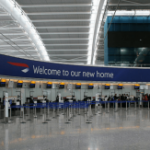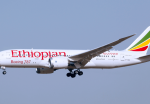Table of Contents
Search Cheap Flights and hotels
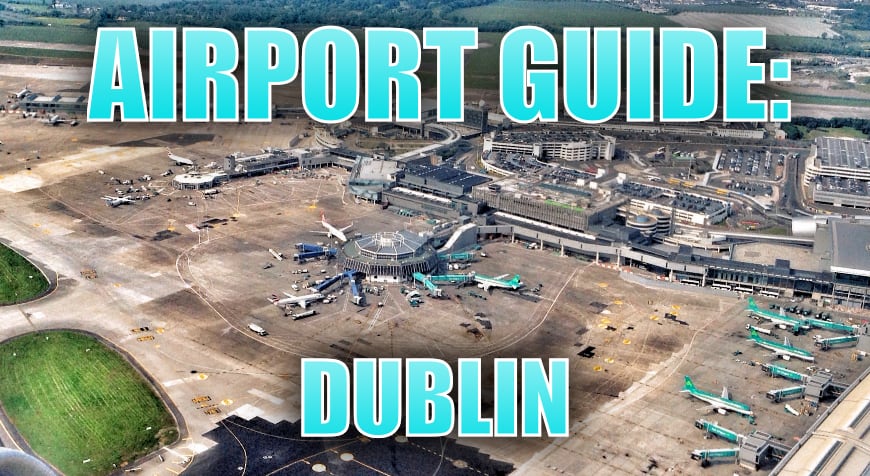
Dublin Airport is the only international and commercial airport serving the capital city of Ireland, Dublin. The airport plays a vital role in aviation not just for Dublin itself, but for the entire country of Ireland. Of the 38 million passengers that passed through airports in Ireland in 2019, Dublin was responsible for 32 million of them. Chances are if you are flying to or from Ireland, you’ll be utilising this airport so make sure you know everything you need to with our Dublin Airport Guide!
Dublin Airport plays an essential role for multiple European airlines. Aer Lingus, the flag carrier airline of Ireland, have their headquarters here. The low-cost carriers of Ryanair and Norwegian Air International also are headquartered at Dublin Airport along with regional airline, Stobart Air.
Although the most popular routes from Dublin are to the UK, Dublin Airport continues to grow in status for long-haul aviation and has excellent links to the USA, in particular. In fact, Dublin is one of just three airports on the planet which benefits from United States border preclearance. This privilege means passengers travelling to the USA will have the luxury of being treated as a domestic passenger on arrival. With many U.S. airports suffering from long immigration queues, this can really save time and start any American trips off on a good note.
Dublin Airport At-a-glance
Official Website: https://www.dublinairport.comAirport Code: DUB
Terminals: 2
Address: Dublin Airport
Collinstown,
Fingal,
Dublin County,
IRELAND
Gate Checker: https://www.dublinairport.com/flight-information/live-departures
Terminal Checker: https://www.dublinairport.com/flight-information/airlines
Contact Number: +353 1 8141111
Timezone: GMT+0 October-March, GMT+1 March-October
Lost Property Contact:
Website: https://www.dublinairport.com/at-the-airport/help-and-support/view-lost-property
Phone: +353 1 8145555
Map: https://www.dublinairport.com/at-the-airport/facilities/maps Several 2D and isometric maps for the terminals and transport areas around the airport giving an overview, but not detailed insight.
WiFi: Free WiFi is available throughout the airport. Connect to the “Dublin Airport Wi-Fi” network
Apps: Dublin Airport has a free app available on both AndroidandiOS.
Dublin Airport Facilities
Despite its importance for Irish travel, Dublin Airport itself is not brimming with amenities; however, it does have all the essentials required when travelling but passengers shouldn’t expect more. All the usual airport conveniences are present with currency exchange, free WiFi, ATM’s, luggage storage, luggage trolleys (for free!), baby and children areas, restaurants, cafes, duty-free shopping, power outlets for mobile devices, and a rest zone in Terminal 1
Although the country of Ireland is becoming less reliant on the church, religion is still important. The Our Lady of Heaven Church is within airport grounds (pre-security), and there it holds a daily mass for worshippers to attend. Anyone wishing to participate will find the service running at 1PM Monday to Saturday, or 11:30AM on Sundays. Confession is available on request after mass also. Passengers should head outside from the arrivals hall and follow the signs. The churches website
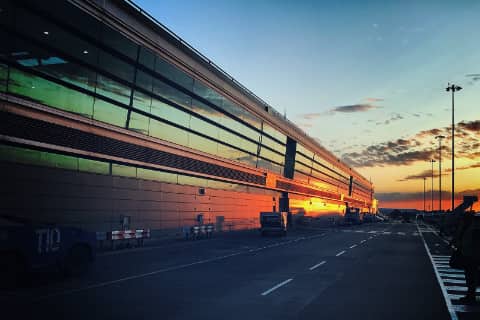
Though passengers will find little entertainment at Dublin Airport, premium services are still possible for those happy to spend some money to enhance their visit. There are several pay-to-enter airport lounges at Dublin Airport (details at the bottom of this guide), as well as a Fast Track service to minimise waiting times. The Fast Track service costs only €5.95-€7.99 per person and will minimise any delays when passing through security. Regular visitors to Dublin Airport may benefit from joining the ‘Airport Club’ scheme which has an annual fee but gives access to lounges, parking, and fast track services. Click here for more information.
Sleeping options are limited but available for passengers on a budget at Dublin Airport. There is a rest zone in Terminal 1 once past security where passengers can stretch out a little more with comfortable soft seating and no armrests. Plus there are ‘sleep pods’, though they are essentially shallow circular holes in the wall with cushions all around them where an individual can sit down. Lying down wouldn’t be possible, and taller passengers could struggle to relax in the enclosed space.
Of course, there are conventional hotels nearby to Dublin Airport too where passengers can find full privacy and beds to rest up at. There are no hotels within the airport itself. Several hotel chains such as the Radisson Blu, Premier Inn, Holiday Inn Express offer shuttle services but are walking distance from Dublin Airport. The Maldron Hotel is the closest hotel from the Terminals and is approximately a three-minute walk when exiting the arrivals area. All the hotels in the Dublin Airport area, as well as the best prices for your dates of travel, are available here.
Shower facilities are not available for free for passengers at Dublin Airport. However, passengers who would like to freshen up after, during or before their travels who would prefer to avoid hotels can make use of the several airport lounges which offer shower facilities. The T1 Lounge and T2 Lounge in their respective terminals allow pay-at-door access and both offer showers. Any business travellers with access to airline lounges may find the lounge(s) included in their program have showers too. Further details are at the end of this Dublin Airport Guide.
Luggage storage solutions are made possible by Excess Luggage Company. Passengers looking to store their baggage can find the service at Terminal 1 Arrivals (6AM-5PM), Terminal 1 Departures (10AM-7PM), or Terminal 2 Check-in (9AM-1PM). Prices start at €7 for 4 hours, €12.50 for 24 hours, €20 for 48 hours, and then €5 per 24 hour period after that. There is a flat fee in operation regardless of luggage size.
Check prices and Book Cheap flights and hotels Now
Dublin Airport Terminal Layout
As mentioned earlier in this guide, Dublin Airport has two terminals. Terminal 2 is the newer of the two having opened in 2010. Terminal 1 has received several improvements and extensions over the years too. The two terminals share a pedestrian corridor that connects them when landside. As such, passengers who need to transfer between terminals for a connecting flight cannot do so airside.
Today the terminals are mostly grouped between airlines offering long-distance travel and those offering short/medium-haul routes. Ryanair, who exclusively fly short-haul destinations, have their home at Terminal 1. Meanwhile Terminal 2 homes all the airlines operating routes to the USA, primarily Aer Lingus. Terminal 2 is significant as it has one of only three US-preclearance facilities at an airport in the world.
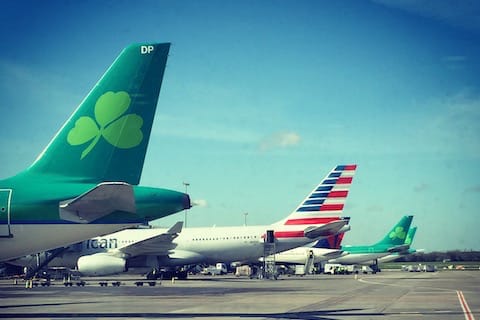
Terminal 1
Terminal 1 of Dublin Airport, where the short/medium-haul flights operate from, has three piers from which flights operate with a central shopping area called ‘The Loop’ connecting the three. Two food courts are on the floor above The Loop for hungry travellers. Passengers can check to see where their flight departs by checking the gate number on their boarding pass.
Gates in the 100’s (101-121) are accessible via a corridor at the far end of The Loop and are the longest walk from the security area. Gates in the 200’s (200-220) are also at the end of The Loop, but without any corridor to travel through. Finally, the gates in the 300’s (301-313) are to the left before The Loop.
Terminal 2
Dublin Airport Terminal 2 is where long haul flights, in particular to the USA, depart from. There is a shopping area called The Loop here as well, which is where passengers will enter when passing through security. Similar to Terminal 1, the food court area is above the shopping facilities.
All gates in Terminal 2 have numbers between 401 and 426. The gates run either side of a pier, with gates 401-406 dedicated to U.S.-bound flights. These are where U.S. preclearance checks take place. Passengers heading to other destinations will not be able to proceed to these gates.
Dublin Airport Connections
Despite repeated discussions to expand transportation options to and from Dublin Airport, passengers can only make their way to Dublin or elsewhere in Ireland by starting their journey via road. There is no rail system connecting Dublin Airport to Dublin, or the rest of the country. This exclusion means passengers wanting to use the national rail services and connections to the local tram system (called Luas) must make their way into Dublin via bus, taxi, or a hire car first before any onward travel.
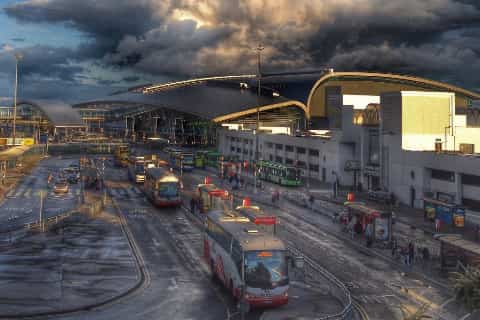
Bus: Without any trains to Dublin, companies offer public transport options via bus and coach instead. Aircoach offers routes into Dublin as well as to Cork and Belfast on the rest of the island. To get into Dublin will take around half an hour at the cost of €9 for a single trip. For those on a shorter visit, a €15 return is possible. Aircoach buses depart every 15 minutes and run 24 hours a day.
The local bus company, Dublin Bus, operates the AirLink Express service. Like the Aircoach, there are departures every 15 minutes or so, but for a lower cost of €7 for a single or €12 for a return. The local public transport ‘daycard’ service, the Leap card, is accepted on the AirLink Express but be aware that it charges €7 for every AirLink Express journey rather than counting towards the daily cap. The AirLink Express travels to Connolly Station or Heuston Station. Local bus routes from Dublin Bus are possible too for locals, which are much cheaper, but they stop frequently and thus take much longer.
Car: Many of the standard international car rental companies operate from Dublin Airport. Sixt, Avis, Alamo, Hertz, Europcar, Budget, Enterprise, and National have a presence at the airport. All of them aside from Europcar are available at both terminals. Additionally, local companies Dooley and NewWay provide further choice for passengers. Passengers can find contact details for all the companies on the Dublin Airport website.
Taxi: Dublin Airport is roughly a 13-15km drive to the city centre of Dublin, and a taxi should take 25-30 minutes to reach any central destination, depending on traffic. This journey time can easily double if travelling during the rush hour with traffic in Dublin. Expect a total cost of around €20-€30 if taking a taxi. Uber and myTaxi are options for e-hailing services which will give a fixed price ahead of travel too.
Connections
Any passengers who are visiting Dublin Airport as part of a connecting flight will generally find their flights will arrive and depart from Terminal 2 as it is the airports long-haul terminal. If a traveller purchased their flights with the airline directly, or with an Online Travel Agency, then their ticket will cover both flights. The airline will already have considered any time to connect within the airport, which means passengers don’t need to worry if their connection looks too short. Any luggage that a passenger checks-in automatically transfers to the second flight also. If the first flight arrives too late, or if the connecting flight isn’t possible to take for reasons outside of a passengers control, the airline is obliged to provide alternative onward travel, and accommodation if necessary.
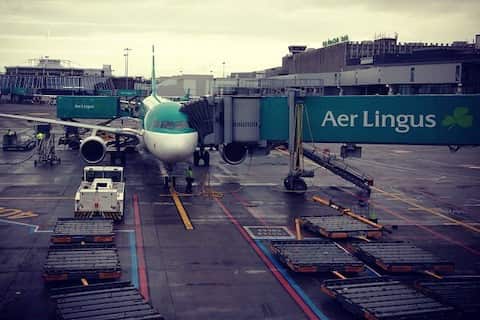
However, in a situation where a traveller is flying on a ‘self-transfer’ ticket, then they do not benefit from the same protections. A self-transfer is when the inbound and outbound flights are independent purchases of the passenger from two separate airlines/travel agencies. In this case, the airline will not assist for any missed second flight, aside from selling a second ticket. If the flyer is travelling with any checked luggage, they will need to collect it and check it in once again for the second flight too. This adds additional time to the connection. If arriving from a non-Schengen country, then time passing through immigration will add to the total connection time too, adding further delays.
The minimum connection time at Dublin airport is 90 minutes, which passengers should use as a guide rather than a rule. However, it’s worth pointing out that Dublin Airport received the honour of being the best airport to self-transfer at in Europe in 2016. Nonetheless, we would recommend at least 2 hours between the arrival time of any passengers first flight and the departure time of their second, ideally longer to protect against any delays.
Dublin Airport Lounges
Both of Dublin Airport’s terminals have several lounges for business travellers to make use of, or for any economy class passengers happy to pay extra. Aer Lingus is the only airline that has any lounge presence with its Terminal 2 occupancy. Nonetheless, there are several independent lounges possible for passengers to use in both Terminal 1 and Terminal 2.
Terminal 1 Lounges
T1 Lounge (this lounge has shower facilities)
Accessible via the stairs/lifts in the security area, but after passing through
The East Lounge (this lounge has shower facilities)
Located airside (i.e. after security) between Terminal 1 and 2
Terminal 2 Lounges
Aer Lingus Lounge (this lounge has shower facilities)
Located between 300 and 400 gates, past The Loop
T2 Lounge
Located past the retail areas, down the escalator
51st & Green Lounge (this lounge has shower facilities)
Located near gates 405/406 once past U.S. preclearance
Aer Lingus Revival Lounge
Located near baggage reclaim belt 6 in the baggage reclaim area
Plaza Premium Lounge (this lounge has shower facilities)
Located on the third floor, near gate 40



